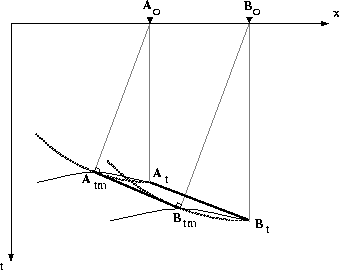 |
Figure 1 De-migration in terms of ray geometry.
Interpreters are much more comfortable interpreting time migrated sections than stacked sections. Time migrated sections give a much clearer structural picture of the subsurface than stacked sections but are inherently mispositioned due to the limitations of time migration.
The parameters that could be observed on the time migrated sections or maps are not reflecting the geological reality. As a matter of fact, time migration does not always produce properly migrated time sections. This is the reason why it is necessary to do (time) de-migration. This method allows us to retrieve all the information needed to perform depth migration. De-migration means cancelling the effect of time migration. The principle of de-migration corresponds to the inverse operation of time migration.
 |
In figure (1), one can see the time migrated position AtmBtm of a dipping reflector. De-migration is performed to retrieve the observed time position AtBt in the inverse way that was applied to do time migration.
In terms of ray geometry we can formulate de-migration as a ``ray-tracing'' from a time migrated position Atm to the position A0 on the free surface in order to retrieve the observed time t0, this is the time that has been measured during seismic acquisition. The ray, as it is built, is perpendicular to the time migrated event locally depth converted at the Atm position.
3-D de-migration equations are then expressed as Kirchhoff time
migration inverse formulation:
![\begin{displaymath}
\begin{array}
{l}
x_0 = x_m + t_m \frac{V_{rms}^2}{4}
\le...
...frac{\partial t}{\partial y} \right)_m^2 \right]}}
\end{array}\end{displaymath}](img1.gif)
(1)